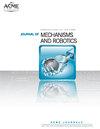用于人体平衡增强的多余机械尾巴的力学特性
IF 3.2
4区 计算机科学
Q2 ENGINEERING, MECHANICAL
Journal of Mechanisms and Robotics-Transactions of the Asme
Pub Date : 2023-08-02
DOI:10.1115/1.4063094
引用次数: 1
摘要
从刚体系统的角度来看,人类在安静的姿势中本质上是不稳定的;然而,由于神经肌肉的感觉控制特性,它们能够保持平衡。随着全球工业和老龄化人口中与平衡相关的事件每年都在增加,开发辅助机制以增强人类平衡至关重要。这项工作研究了用于平衡增强的运动学不同的一自由度和二自由度多余机器人尾巴的机械特性。通过动态模拟和操纵性评估,强调了可变耦合惯性在产生足够反作用扭矩方面的重要性。结果表明,只有旋转关节的两自由度尾部最适合解决平衡增强问题。在两个自由度选项中,研究了开环和闭环尾部的特性,最终的设计选择需要在环境工作空间、生物力学因素和制造容易性之间进行权衡。本文章由计算机程序翻译,如有差异,请以英文原文为准。
Mechanical characterisation of supernumerary robotic tails for human balance augmentation
Humans are intrinsically unstable in quiet stance from a rigid body system viewpoint; however, they maintain balance thanks to neuro-muscular sensory control properties. With increasing levels of balance related incidents in industrial and ageing populations globally each year, the development of assistive mechanisms to augment human balance is paramount. This work investigates the mechanical characteristics of kinematically dissimilar one and two degrees-of-freedom supernumerary robotic tails for balance augmentation. Through dynamic simulations and manipulability assessments, the importance of variable coupling inertia in creating a sufficient reaction torque is highlighted. It is shown that two-dof tails with solely revolute joints are best suited to address the balance augmentation issue. Within the two-dof options, the characteristics of open versus closed loop tails is investigated, with the ultimate design selection requiring trade-offs between environmental workspace, biomechanical factors and manufacturing ease to be made.
求助全文
通过发布文献求助,成功后即可免费获取论文全文。
去求助
来源期刊

Journal of Mechanisms and Robotics-Transactions of the Asme
ENGINEERING, MECHANICAL-ROBOTICS
CiteScore
5.60
自引率
15.40%
发文量
131
审稿时长
4.5 months
期刊介绍:
Fundamental theory, algorithms, design, manufacture, and experimental validation for mechanisms and robots; Theoretical and applied kinematics; Mechanism synthesis and design; Analysis and design of robot manipulators, hands and legs, soft robotics, compliant mechanisms, origami and folded robots, printed robots, and haptic devices; Novel fabrication; Actuation and control techniques for mechanisms and robotics; Bio-inspired approaches to mechanism and robot design; Mechanics and design of micro- and nano-scale devices.
 求助内容:
求助内容: 应助结果提醒方式:
应助结果提醒方式:


